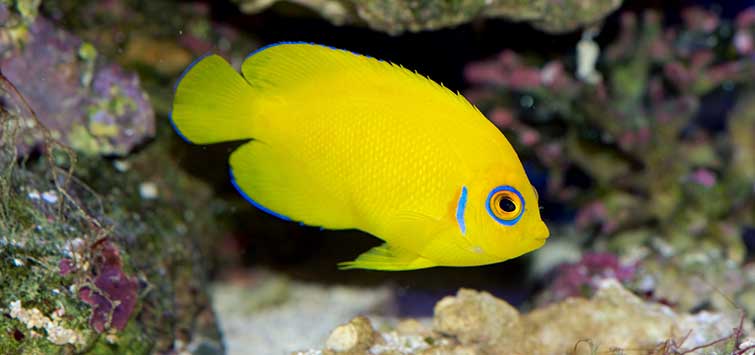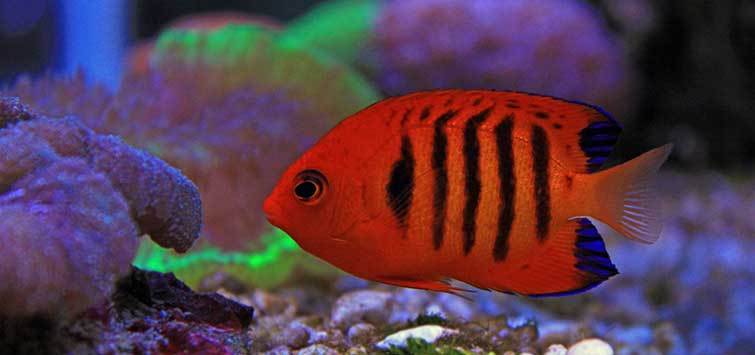Centropyge flavissima
Common Names: Lemonpeel angelfish, lemon angel, lemon dwarf angelfish, blue-eyed dwarf angel
Type Locality: Ulea, Caroline Islands
Range: Western and southern Indo-Pacific: Cocos-Keeling Atoll, Marquesan, Ducie, and Easter Islands, north to the Ryukyu Islands, south to New Caledonia and Rapa. Not reported from Indonesia, Malaysia, Hawaii, or Johnston Atoll. (Found as an introduced exotic in
Taxonomic Troubles: Originally described as Holacanthus flavissimus, known for a long time as Centropyge flavissimus, with wrong gender for the specific epithet.
Size: 14 cm TL (5.5 inches), usually smaller.
Preferred Water Chemistry: Tropical marine, found in shallow water on reefs.
Difficulty: A medium-hardy species. Like all Centropyge, this fish is sensitive to medications. Do not confuse with C. heraldi, which lacks the blue ring around the eye and which is very unlikely to survive.
Tank Setup: Lots of live rock, with plenty of hiding places. This fish is fairly peaceful but may pick on very passive fish. Hobbyists' experiences with it in a reef tank are mixed; it may pick at sessile invertebrates.
Feeding: An omnivore that can usually be trained to prepared foods. Algae is an important component of the diet, which is why they do best in mature systems.
Breeding: As with other species in this genus, the fish will spawn in the home aquarium.
Fish Description
Intense yellow with light blue highlights: ring around the eye, edge of the operculum, and the unpaired fins. Juveniles have a black ocellus ringed in blue on the flanks. This species is mimicked by juvenile Acanthurus pyroferus.
Notes
There are not many all-yellow fish, and they are usually quite popular. Although not as ubiquitous as the yellow tang (Zebrasoma flavescens), this yellow angel is commonly available. This fish provides a good example of the silliness of many common names. It is often called the "true" lemonpeel angel, with the similar C. heraldi being called the "false" lemonpeel angel. This probably reflects the much greater suitability of C. flavissima for the home aquarium, but it's a distinction without merit. Either species can be—and is called—the lemonpeel angel, and there's nothing true or false about either.
As with other dwarf angels, the major issue is whether this species is "reef safe." There is no doubt that it will thrive in a reef tank, but it may do so at the expense of expensive invertebrates. Individuals vary considerably in this regard. The alternative is a FOWLR setup. The security and snack foods provided by a live-rock setup will make this angel feel right at home.
The other issue concerns tankmates; very passive fish like clowns may be harassed by this inquisitive and outgoing species, but the lemon angel is generally well behaved. It will definitely fight with other dwarf angels, especially its own species, unless it is kept in a very large aquarium with plenty of live rock as visual barriers.

.png?h=595&iar=0&w=2781&hash=5FD5E69473BCC22199FBFA2FB71B6033)


